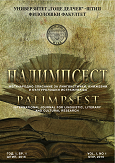DOWRY TRADİTİON AND TRANSFORMATİON İN MACEDONİAN IMMİGRANTS LİVİNG İN IZMİR
DOI:
https://doi.org/10.46763/PALIM24918137iAbstract
This study analyzes the dowry cultures of individuals who migrated to Izmir, Turkey, through "free migration" from various settlements (Zivegor, Dırjılova, Rostuşa) in Yugoslavia—now North Macedonia—between 1950 and 1960. The analysis highlights the intergenerational changes in dowry practices. The author conducted a field research document dowry elements, with visits to Izmir at different intervals. This approach was chosen in order to provide a detailed and consistent examination of dowry elements, as well as interpretations shaped by migrants' memories over time. The study focused on the Çamdibi and Altındağ neighborhoods in the Bornova district of Izmir, where 17 informants were interviewed. The subject of research of this study is the dowry culture of migrant women living in these two neighbourhoods. A review of the literature revealed that there are no prior studies on these areas and the findings emphasize that dowry serves both, memory-related and identity roles for this community. In the light of the data obtained from the field research revealed that sewing machines and looms, known as razboys, were brought along during the migration. These tools played a significant role in preserving the dowry tradition, enabling its transmission from the first generation of migrants to the second through the memory-related practices of women after migration.
Keywords: İzmir; Macedonian immigrants; dowry; memory; migration.


